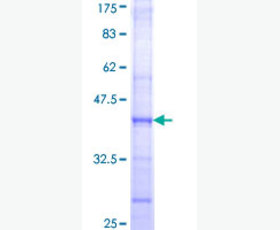Recombinant Human Early Placenta Insulin-Like Peptide/INSL4/Placentin
| Product name: | Recombinant Human Early Placenta Insulin-Like Peptide/INSL4/Placentin |
| Source: | Human Cells |
| Purity: | Greater than 95% as determined by reducing SDS-PAGE. |
| Buffer Formulation: | Lyophilized from a 0.2 μm filtered solution of 20mM Tris,150mM NACl,pH 8.0. |
| Applications: | Applications:SDS-PAGE; WB; ELISA; IP. |
| Storage: | Avoid repeated freeze/thaw cycles. Store at 2-8 oC for one month. Aliquot and store at -80 oC for 12 months. |
| UOM: | 100ug/50ug/200ug/1mg/1g |
| Source | Human Cells |
| Description | Recombinant Human Placentin is produced by our Mammalian expression system and the target gene encoding Ala26-Thr139 is expressed with a 6His tag at the C-terminus. |
| Names | Early Placenta Insulin-Like Peptide, EPIL, Insulin-Like Peptide 4, Placentin, INSL4 |
| Accession # | Q14641 |
| Formulation | Lyophilized from a 0.2 μm filtered solution of 20mM Tris,150mM NACl,pH 8.0. |
| Shipping |
The product is shipped at ambient temperature. |
| Reconstitution |
Always centrifuge tubes before opening. Do not mix by vortex or pipetting. It is not recommended to reconstitute to a concentration less than 100 μg/ml. Dissolve the lyophilized protein in ddH2O. Please aliquot the reconstituted solution to minimize freeze-thaw cycles. |
| Storage |
Lyophilized protein should be stored at < -20°C, though stable at room temperature for 3 weeks. Reconstituted protein solution can be stored at 4-7°C for 2-7 days. Aliquots of reconstituted samples are stable at < -20°C for 3 months. |
| Purity |
Greater than 95% as determined by reducing SDS-PAGE. |
| Endotoxin | Less than 0.1 ng/µg (1 IEU/µg) as determined by LAL test. |
| Amino Acid Sequence |
AELRGCGPRFGKHLLSYCPMPEKTFTTTPGGWLLESGRPKEMVSTSNNKDGQALGTTSEFIPNLS PELKKPLSEGQPSLKKIILSRKKRSGRHRFDPFCCEVICDDGTSVKLCTVDHHHHHH
|
| Background | Early Placenta Insulin-Like Peptide (INSL4) belongs to the insulin family. INSL4 is expressed in the early placental cytotrophoblast and syncytiotrophoblast INSL4 is a secreted protein and a precursor that undergoes post-translational cleavage to produce 3 polypeptide chains, A-C, that form tertiary structures composed of either all three chains, or just the A and B chains. INSL4 plays an important role in the development of trophoblast and in the regulation of bone formation. |














